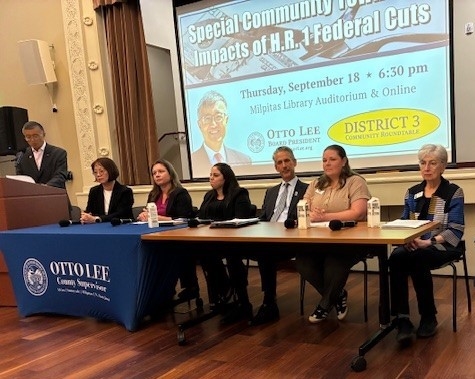District 3 Santa Clara County Supervisor Otto Lee succinctly summed up his opinion of HR1—aka President Donald Trump’s “Big Beautiful Bill”—at a Sept. 18 town hall meeting at the Jose Esteves Milpitas Library.
“It’s a big bill but not beautiful,” Lee said of HR1, which catalyzed massive federal budget cuts when Trump signed it into law July 4.
HR 1 cuts $186 billion from the Supplemental Nutrition Assistance Program (SNAP) and $1 trillion from Medicaid, which provides healthcare access for one in five Americans and almost half of all children in the U.S.
Santa Clara County stands to lose more than $1 billion in federal funding. “We have never faced a financial crisis like this in 40 years,” Lee said.
The cuts will affect 465,000 Santa Clara County residents relying on Medicaid, 133,000 who get food assistance through SNAP and more than 72,000 adults relying on state-only Medi-Cal for healthcare coverage.
It is projected that 12 million Americans will lose Medicaid coverage, including 3.4 million Californians. Medicaid is the largest source of federal funding for Santa Clara County. The funding supports programs for child welfare, food assistance, housing, public safety and health, and other critical services.
Santa Clara County operates the second largest hospital system among the 58 counties in California. Major funding for this system comes from the federal government through Medicare and Medicaid.
Santa Clara Valley Medical Center CEO Paul Lorenz to town hall attendees that aside from dramatically reducing payments to medical providers, HR1 requires major eligibility changes, resulting in individuals being unable to access primary healthcare because they are unable to pay.
“This is not about politics. It’s about people’s lives,” added Dr. Phuong Nguyen, chief medical officer at Santa Clara Valley Medical Center
Sunnyvale Community Services Executive Director Marie Bernard cited the 25,000 Medicare beneficiaries in her neighborhood, saying they were all migrants because “they have to navigate the maze of holes” in “the safety nets.”
“This suffering is not needed,” Bernard said. “What causes poverty in Silicon Valley, one of the richest areas?”
Santa Clara County’s response to the threats of federal budget cuts has, in part, been hiring freezes and staff reductions that eliminated about 800 positions in the past three fiscal years.
On Aug. 7, the Board of Supervisors approved placing Measure A—an emergency, temporary general tax measure of 5/8 of a cent—on the November ballot. If approved by the county’s voters, the five-year tax could generate up to $330 million in annual revenues.





